
The genus Androstephium is a group of North American plants in the cluster lily subfamily within the asparagus family. It contains two species native to the southwestern and south-central United States.

Phacelia fremontii is a flowering plant in the family Boraginaceae native to the southwestern United States. In California, its range includes the Mojave Desert, the San Joaquin Valley, the Coast Ranges, and the Sierra Nevada. It was named for John C. Frémont.
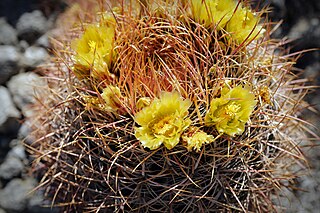
Ferocactus cylindraceus is a species of barrel cactus which is known by several common names, including California barrel cactus, Desert barrel cactus, compass barrel cactus, and miner's compass. It was first described by George Engelmann in 1853.
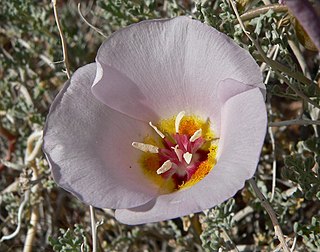
Calochortus flexuosus is a species of lily known by the common names winding Mariposa lily and straggling Mariposa lily.

Calochortus striatus, known by the common name alkali mariposa lily, is a species of mariposa lily native to California and into Nevada.

Lycium andersonii is a species of flowering plant in the nightshade family, Solanaceae. Its common names include water-jacket, redberry desert-thorn, Anderson thornbush, Anderson's desert thorn, Anderson boxthorn, Anderson lycium, Anderson wolfberry, and squawberry.

Erythronium grandiflorum is a North American species of plants in the lily family. It is known by several common names, including yellow avalanche lily, glacier lily, and dogtooth fawn lily. The Ktunaxa name for glacier lily is maxa.

Brickellia californica, known by the common name California brickellbush, is a species of flowering plant in the family Asteraceae.

Calochortus uniflorus is a species of flowering plant in the lily family known by the common names Monterey mariposa lily and large-flowered star-tulip. It is native to western Oregon and to California as far south as San Luis Obispo County. It grows in moist areas, such as meadows, in coastal hills and lower-elevation mountains. Most of the populations are found in the Coast Ranges, but some occur in the Cascades and in the foothills of the Sierra Nevada.

Leptosiphon grandiflorus is a species of flowering plant in the phlox family known by the common names large-flower linanthus and large flowered leptosiphon.

Peteria thompsoniae is a species of flowering plant in the family Fabaceae known by the common names spine-noded milkvetch and Thompson's peteria. It is native to the western United States, where it grows in salt desert shrublands in soils of volcanic ash origin, and in alluvial fans. It is a spiny perennial herb growing from a taproot and rhizome system, its stem growing 20 to 60 centimeters tall. The leaves are made up of several pairs of oval leaflets. The inflorescence, a spikelike raceme at the top of the stem, produces white or pinkish pealike flowers up to 2.5 centimeters long, its base encapsulated in a tubular calyx of glandular sepals. The fruit is a leathery, slightly inflated legume pod up to 6 centimeters long.
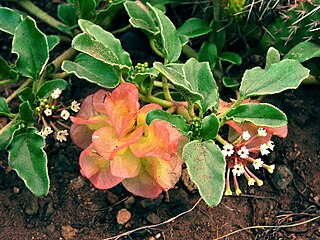
Tripterocalyx micranthus is a species of flowering plant in the four o'clock family known by the common names smallflower sandverbena and small-flowered sand-verbena.
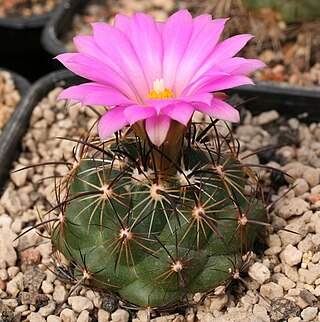
Coryphantha ramillosa is a rare species of cactus known by the common names bunched cory cactus and whiskerbush. It is native to the border region between Texas in the United States and Coahuila in Mexico. Because it was believed to be rare and threatened by a number of processes, it was federally listed as a threatened species of the United States in 1979.

Echinocereus viridiflorus is a species of cactus known by the common names nylon hedgehog cactus, green pitaya, and small-flowered hedgehog cactus. It is native to the central and south-central United States and northern Mexico, where it can be found in varied habitat types, including desert scrub, woodlands, dry grasslands, and short-grass prairie.

Lepidium barnebyanum is a rare species of flowering plant in the family Brassicaceae known by the common names Barneby's pepperweed, Barneby's pepper-grass, and Barneby's ridge-cress. It is endemic to Utah, where there is a single population in Duchesne County. It is a federally listed endangered species of the United States.
Hastingsia bracteosa is a rare species of flowering plant in the agave subfamily of the asparagus family known by the common name large-flowered rushlily. It is endemic to Oregon in the United States, where it is limited to a twelve-mile stretch of the Illinois Valley in the southwestern part of the state.

Vaccinium myrsinites is a species of flowering plant in the heath family known by the common name shiny blueberry. It is native to the southeastern United States from Alabama, Georgia, South Carolina and Florida. It may occur as far west as Louisiana.

Cochemiea thornberi is a species of cactus known by the common names Thornber's fishhook cactus and Thornber's nipple cactus. It is native to Arizona in the United States and Sonora in Mexico.
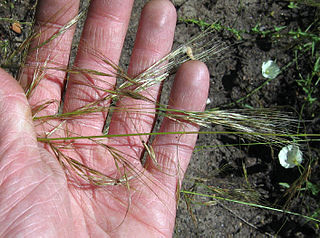
Nassella lepida is a species of grass known by the common names foothill needlegrass, foothills nassella, foothill stipa, small-flowered stipa, small-flowered needlegrass, and smallflower tussockgrass.

Eremocrinum is a monotypic genus of plants in the subfamily Agavoideae containing the single species Eremocrinum albomarginatum. It is known by the common names Utah solitaire lily, Intermountain false-wheatgrass, desert lily, lonely lily, and sand lily. It is native to the western United States, where it is known from Arizona and Utah.




















